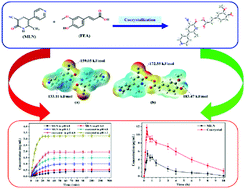Drug-nutrient cocrystallization-driven strategy towards self-assembly of milrinone and ferulic acid provides an exemplification in perfecting in vitro/vivo characteristics of anti-heart failure drugs†
Abstract
A drug-nutrient cocrystallization-driven strategy has been established to highlight the superiority of nutraceutical ferulic acid (FEA) in perfecting the biopharmaceutical peculiarities of anti-heart failure drug milrinone (MLN). Taking the strategy as guidance, a novel cocrystal of MLN with FEA, namely MLN–FEA, is assembled and characterized, which reveals that the obtained solid form is a cocrystal of MLN molecule and FEA with the ratio of 1 : 1. There are milrinone–ferulic acid hydrogen-bonding couples, which are assembled into hydrogen-bonding chains in the crystal, and these chains connect the bilayer structure of MLN molecules gathering with π⋯π interactions of C![[double bond, length as m-dash]](https://www.rsc.org/images/entities/char_e001.gif) O/CN groups with the pyridine rings to the whole three-dimensional framework. The combination of theoretical and experimental approaches proves that the aggregation motifs and structural features constituted by the introduction of ferulic acid in the crystal lattice have a significant effect on improving the solubility and permeability of the cocrystal. Interestingly, compared with the parent drug MLN, the ameliorated properties in vitro can be effectively transformed into a pharmacokinetic trait in vivo, revealing the extended half-life and raised bioavailability. Thereby, the current research not only supplies a novel solid form of MLN with potential commercial value, but provides some new opinions for the applications of nutritients in cardiotonic pharmaceutical cocrystals.
O/CN groups with the pyridine rings to the whole three-dimensional framework. The combination of theoretical and experimental approaches proves that the aggregation motifs and structural features constituted by the introduction of ferulic acid in the crystal lattice have a significant effect on improving the solubility and permeability of the cocrystal. Interestingly, compared with the parent drug MLN, the ameliorated properties in vitro can be effectively transformed into a pharmacokinetic trait in vivo, revealing the extended half-life and raised bioavailability. Thereby, the current research not only supplies a novel solid form of MLN with potential commercial value, but provides some new opinions for the applications of nutritients in cardiotonic pharmaceutical cocrystals.



 Please wait while we load your content...
Please wait while we load your content...